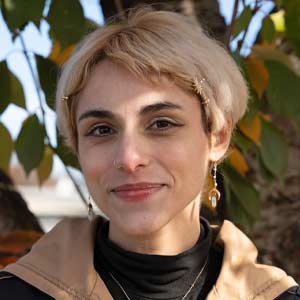Q&A with Professor Mary Winalski
Everyone who pursues higher education has a story. Every time a student enrolls in a degree program, they embark on a journey of personal and professional growth. Regardless of their differing backgrounds and individual career goals, students find unity in their motivation to succeed. Together, they are driven to improve their communities, make a meaningful difference, and support their families.
When she first enrolled as an Occupational Therapy Assistant (OTA) student, Mary Winalski shared that motivation. Like most other Goodwin students, Mary arrived with a story, too. Feeling stagnant in her career, she found herself in search of a professional path that would better support the needs of her growing family. Moreover, Mary dreamed of making a deep and meaningful difference in her community.
By choosing to enroll in Goodwin’s OTA program, Mary put her dream into motion, finding her passion not only as an OTA professional, but as a professor right here at Goodwin! Read on to learn how Goodwin’s OTA program helped Mary find her calling — and how she’s returning the favor by shaping the OTA professionals of tomorrow.
What inspired you to pursue a career as an OTA?
MW: Occupational Therapy was a perfect answer for me when I found myself at a standstill in my prior career. After working in mental health and massage therapy for years, I knew it was time for me to bring my skills to a new level in a setting that has a direct and meaningful impact on people’s lives. I also needed a career that could support my growing family, and the opportunities in occupational therapy seemed accessible and exciting.
Ask Goodwin: What exactly does an OTA do? An occupational therapy assistant helps people with disabilities, cognitive differences, and medical conditions learn, develop, and recover their ability to perform daily tasks and activities.
Why did you choose to earn your degree at Goodwin?
MW: I looked at a few schools, and Goodwin stood out right away. The way their program was organized had a flow to it that was easy to navigate. The classes built upon each other well, and the information and faculty were both easy to access. The way Goodwin structures their schedules made it possible for me, as a working mom, to attend class and to complete my schoolwork while juggling other responsibilities.
Describe how Goodwin’s program helped you develop and refine your skills as an OTA.
MW: The way the professors tied basic knowledge of the human body, mind, and spirit to functional ability painted a beautiful path by which I could help many patients and clients. I had a lot of relevant experience coming into the program, from psychology and massage therapy to reiki healing and auditing billable services. In the OTA program, I learned how to combine my knowledge of anatomy, physiology, psychology, and skills training to support my patients throughout their journey of recovery. What I learned in the program helped me combine and master these concepts in a way that can be applied to patients across a full spectrum of needs.
Ask Goodwin: Wondering how OTAs provide patient-centered care? OTAs support their clients by developing personalized strategies and techniques to maximize their functioning. With the help of a dedicated OTA , clients can improve their quality of life, gain more independence, and maintain a sense of personal dignity.
How did Goodwin’s OTA faculty support you throughout your educational journey?
MW: I was inspired by the excitement that my instructors brought to the classroom. Their real-world experience and clear passion for the work that they do played an important role in developing my understanding and love for this career path.
Why were you drawn to the prospect of becoming a Goodwin faculty member?
MW: When I was in Goodwin’s OTA program as a student, I knew that I wanted to teach here. I was inspired by my instructors and wanted to keep that momentum going. I wanted to carry on the torch, commit to advancing our profession, and help share the incredible opportunity to make people’s lives better through occupational therapy. Given my experiences as a student and professional, I knew that I’d be a perfect fit with the already strong team of OTA faculty. Teaching at Goodwin would also allow me to give back to the community in a way that would have a lasting impact. I have seen how powerful the right frame of mind and set of skills can be when you’re supporting the greater good, and I knew that teaching was an excellent way to set that ripple effect into motion.
Ask Goodwin: Wondering what the job market looks like for an OTA? According to the Bureau of Labor Statistics, the average salary for an OTA is over $60,000 annually. Better still, careers in occupational therapy are booming, with professional opportunities available in a wide variety of settings. The BLS estimates that by 2031, the need for OTAs will grow by 25%.
Speaking as a faculty member, what are some of the biggest challenges OTA students face?
MW: Work-life balance can be a challenge for anyone. Once you add a few classes to the mix, it can be tricky to find the right combination where you are meeting the rigorous standards of the program while still fulfilling your responsibilities outside of school, but that is what OT is all about! I try to make time to help my students find ways to apply OT strategies to their own lives as they navigate their personal and professional responsibilities. I think it is important for students to make sure they set aside time to complete their coursework, but it is also important that they take the time to meet their personal needs.
Ask Goodwin: Need help navigating higher ed? At Goodwin University, we are dedicated to helping you earn your degree. That’s why we offer comprehensive Student Support Services, all geared toward getting you to the finish line. Learn more about how Goodwin can help you crush your career goals.
What is your favorite thing about teaching OTA students?
MW: I love sharing my passion for what occupational therapy can do. It is the best career! There are endless domains in which you can apply OT interventions, so whatever a person’s passion is, OT holds a potential career path.
I love showing students how fulfilling it can be to help others at this level, and I love showing them how to apply the same ideas to their own lives and situations. I’m a big fan of learning theory and I enjoy helping students develop a better understanding of their own learning style, and in doing so, they learn how to help their eventual patients do the same. I am a quirky learner myself, so in my current role, I employ lots of (sometimes totally ridiculous) pneumonic devices that helped me to learn and remember complex information. My students seem to get a kick out of these tips and tricks. I love having the chance to encourage my students to see their eventual patients for who they truly really are as individuals. By doing this, they can help their patients in significant and meaningful ways.
What makes Goodwin a special place to earn your OTA degree?
MW: Goodwin combines all of the great things about bigger colleges and universities with the best things about small schools. Goodwin is a big enough school to have all the resources and support you need, but it’s small enough to maintain a tight-knit feel. The OTA faculty is an amazing team of talented and passionate OT practitioners who are here for the best reasons — we truly want to see our students and our field continue to advance.
OTA — the Goodwin Way
When you enroll in Goodwin University’s OTA program, you can turn your compassion into a rewarding career. Learn more about earning your associate degree in OTA at Goodwin, or call 800-889-3282.

Bri Gagné is a marketing content writer at Goodwin University, bringing backgrounds in literary studies, creative storytelling, Universal Design for Learning (UDL), and social justice. They earned their bachelor’s degree in English Literature and Film Studies from University of Connecticut and a master’s in education from Eastern Connecticut State University.
After teaching English abroad and locally, Bri transitioned to a full-time writing career, contributing to the University’s educational narratives and brand-building efforts. They plan to begin their Master of Fine Arts in creative writing in 2025.

